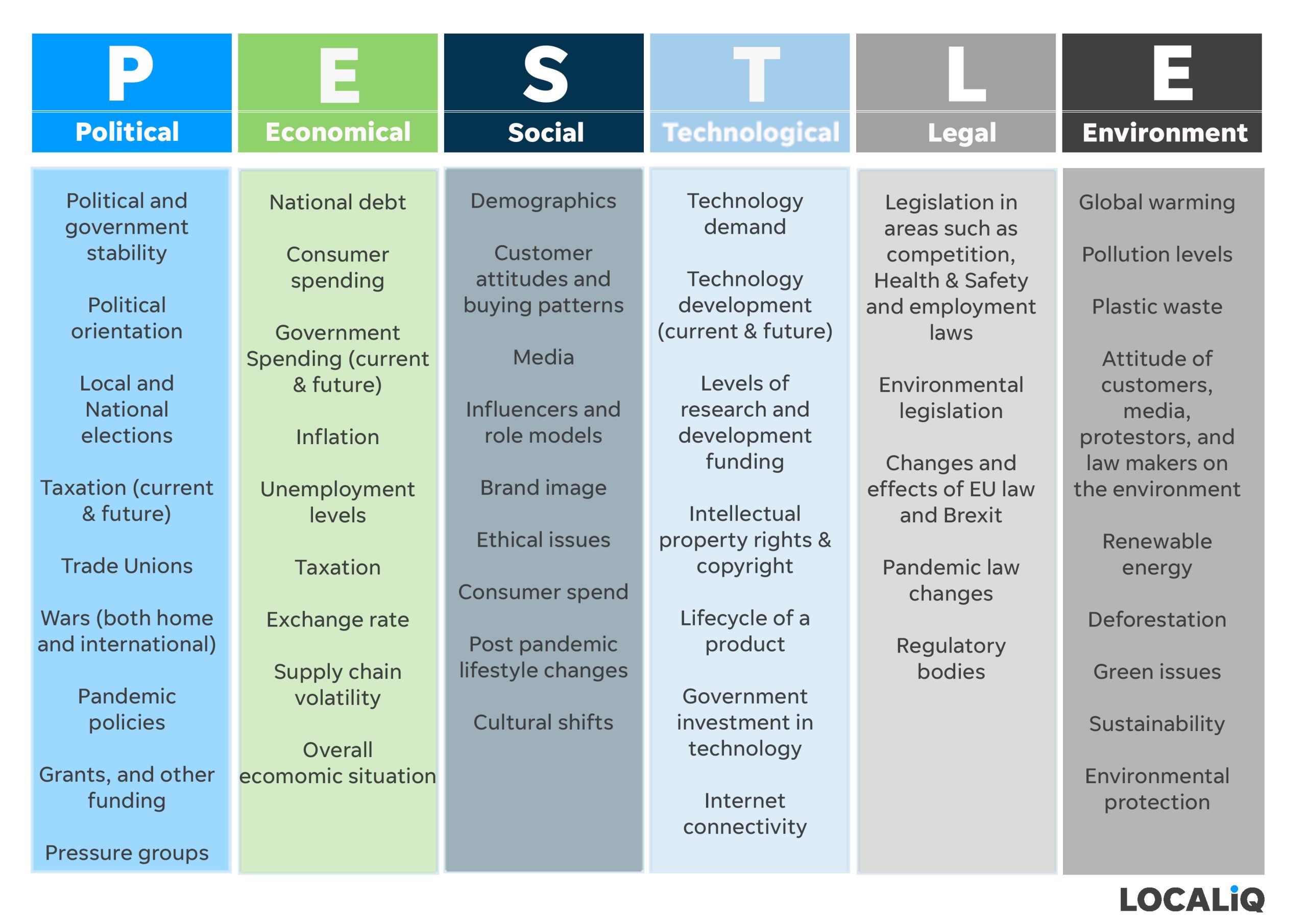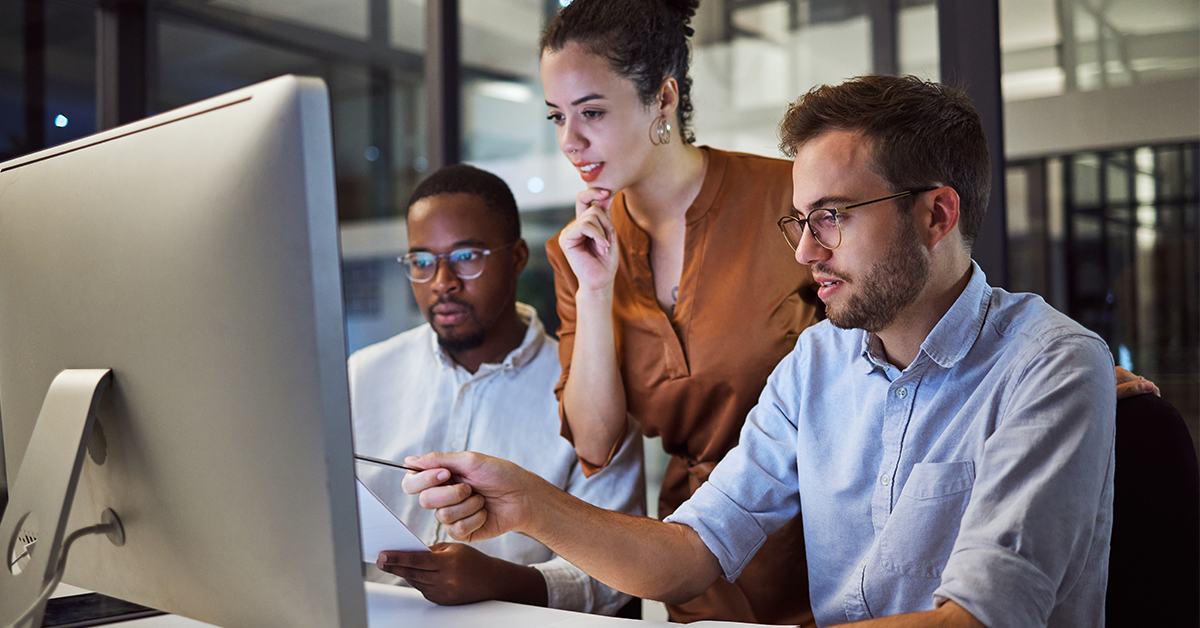You have no doubt heard of both SWOT and PESTLE analysis but may not be sure how to effectively complete them for your business. This guide covers everything you need to know about conducting a SWOT and PESTLE analysis for your business, with a comprehensive breakdown of each section, and a free SWOT & PESTLE template for your business to use. While this blog will cover in-depth everything you need to know, we implore you to download the free resources which can be used by your business to achieve excellence and competitive advantage.
In this blog we will cover:
- What are the main differences between a SWOT & a PESTLE analysis?
- What should be completed first, PESTLE or SWOT?
- What is a PESTLE analysis and why should you do one?
- How to conduct a PESTLE analysis
- What is a SWOT analysis and why should you do one?
- How to conduct a SWOT analysis
What are the main differences between a SWOT & a PESTLE analysis?
The main difference between the two is that a PESTLE analysis focuses only on external forces. A SWOT analysis looks at internal and external factors that can affect a business, such as your internal resources (staff) and tangible assets, and includes what your business is good at.
For PESTLE, external forces can include factors such as legislation, environmental and political issues, consumer spending, and regulatory bodies. And these PESTLE forces form the basis of both opportunities and threats in a SWOT analysis.
What should be completed first, PESTLE or SWOT?
It is wise to do a PESTLE analysis before a SWOT analysis because the information you gather from your PESTLE analysis will help you fill out your SWOT analysis. PESTLE analysis can help massively for the opportunities and threats section.
Don’t forget to download your free SWOT and PESTLE toolkit
What is a PESTLE analysis and why should you do one?
A PESTLE (or PESTEL) analysis gives a macro picture of the industry, covering political, economic, social, technological, legal, and environmental factors which can affect an industry and a business. A strong PESTLE analysis will help you to understand long term trends as well as support a range of business planning situations. You can use a PESTLE for planning a range of business objectives such as strategy, marketing, product development, organisational change, as well as workforce and people planning.

Each aspect of the PESTLE analysis has been broken down into stages to give more information and context on each topic. The important thing to remember when conducting a PESTLE analysis is that these factors can change rapidly and you need to assess all current and potential future changes (for example, changes to tax or legislation).
How to conduct a PESTLE analysis
A PESTLE analysis can be done by one individual or shared out. If you have a legal team for instance, they would likely be the best team to deal with the legal part of the analysis. The PESTLE analysis is focused on looking at how outside influences can affect your business, so make sure you thoroughly research each topic. Remember, Google is always a good place to start gathering information.
Political
Political factors are extremely important to consider, and they are the least predictable elements. Political factors can be assessed from a national and local level. Politics can change rapidly and when governments change (at local and national elections) there could be radical changes for businesses.
With politics governing aspects of law, not adhering to the government policies could result in fines, serious financial loss or even business closure. Think back to when Brexit laws became enshrined in law. Suddenly, businesses had a lot of new regulations to abide by.
While there is a section called legal in PESTLE, it is worth remembering that political policies govern everything from working hours, conditions, and wages, as well as data protection laws, discrimination laws, environmental laws, and health and safety.
The political aspect of PESTLE is mainly concerned with governments; however, you also need to consider trade unions and their collective bargaining power which could impact your business (for example, strikes and wage negotiations).
Wars are another example where a government may reduce business spending, and consumers can see cost rises in raw materials (oil and gas for example). Political stability and instability or elections should also be factored in as new governments can change/reverse current legislation.
The next aspect to consider is taxation. There are many types of taxes that businesses need to be aware of. Some businesses must charge more tax for certain items (e.g., sugar tax). As a business, you need to ensure you stay up to date with any tax changes and assess how they will impact your business.
Economical
Economies are fragile and by understanding the economic factors that can affect a business, you can begin to mitigate risks. Economic changes can be felt locally, on a countrywide basis, or even globally. Economic factors are those which have the potential to affect goods, services, and finances. Things to consider here are interest rates, recessions, inflation, exchange rates as well as supply and demand.
A government may reduce or increase spending, which can affect businesses, and they can also influence working hours, working conditions and wages. Along with working conditions and hours, unemployment rates can also be a factor that affects businesses. Other things to consider here are national debt, cost of living and credit availability.
Social
To better plan for marketing campaigns, one thing that needs consideration is the social changes. Social changes can happen quickly (e.g., in the fashion industry) and a business needs to ensure it is prepared. Social changes can include factors such as cultural norms and expectations (and this can vary greatly if you are marketing globally), population growth and demographic age.
Friends, family, social media, and influences are forces that can impact a consumer’s purchase intent. Social media channels are no longer just platforms for people to connect with each other, they are used by consumers to connect with brands, conduct brand research, and help consumers find the latest trends. On that note, marketers to consider the brand image. Is the brand seen as matching the beliefs and values of its customers? The current cost of living crisis is seeing less consumer spending, as many consumers have less expendable cash, with some consumers using social media to search out more frugal ways of living.
Technological
Technology has changed the way we live our lives. There are constant emerging technologies that disrupt the norm in business. Businesses need to consider embracing these changes as they may influence the success of the brand.
Online ordering changed the way people shop and this has brought about a demand for businesses to have an online presence, (Covid pushed more smaller businesses to build their online presence via websites and social media pages to stay afloat).
Technological changes can include the demand for high-speed broadband for both individuals and businesses, to newer and emerging technologies. Over the past few years, both AI and VR have seen massive growth and these trends are likely to continue growing over the coming years.
Technology also covers research and development (R&D) that can influence and impact a business. The amount a business is willing to invest in these areas can have a profound effect on how the business grows.
Legal
It is a given fact that all businesses need to follow the laws of the countries they operate in. This can differ in many markets, especially if you are marketing overseas. Businesses that operate overseas will have many different laws to consider and this could be a barrier to those markets.
Laws govern everything from employment laws (Equalities Act 2010, Agency Workers Regulations 2010), competition laws, health and safety regulations (Health and Safety at Work 1974, DSE regulations 2002) and discrimination laws.
It is not just the laws from governments you need to be concerned about, you also need to assess laws and regulations from regulatory bodies (these will differ depending on your industry).
Environmental
Environmental and ecological protection has only come to the forefront of business planning in the last 15-20 years. When you consider the scarcity of available raw materials, there is a strong demand for renewable and recyclable materials.
In recent years, Governments have begun setting targets on carbon footprints and pollution targets. They have a net 0 by 2050 meaning that the UK plans to reduce emissions and not add to the number of greenhouse gases in the atmosphere.
Customers are becoming more environmentally conscious from their own shopping habits to expectations from a business. A 2021 study by YouGov showed that 57% of people would pay more for environmentally friendly products. The study further highlighted that 69% of Gen Z would pay more for environmentally friendly products. When applying customers’ expectations to businesses, they want businesses to illustrate and prove they are at the forefront of environmental issues. A business must do more than just say they are ‘green,’ they must prove it, if a business is greenwashing, then they will see a downturn in customers and potential media backlash.
Don’t forget to download your free SWOT and PESTLE toolkit
What is a SWOT analysis and why should you do one?
A SWOT analysis covers a business’s strengths, weaknesses, opportunities, and threats. When conducted thoroughly, it can help a business to make changes to increase its longevity and performance. A SWOT analysis is as important for a sole trader as it is for a multi-national company for analysing the business and its wider sector. In short, a SWOT analysis is a framework for managing the business goals and capabilities in the environment in which it operates.

Strengths – An internal factor that assesses the strengths of a business by looking at both its tangible and intangible assets.
Weaknesses – An internal factor that assesses where the business can improve
Opportunities – These are external factors that focus on opportunities the business can adopt to achieve growth.
Threats – Another external factor that is beyond the business’s control but could allow the business to form contingency plans should they arise.
While a SWOT analysis can be undertaken on the whole business, it is also especially useful to use in smaller projects and campaigns, as well as teams and individuals.
How to Conduct a SWOT Analysis
To conduct a SWOT analysis, you need to be honest and take your time to look inwards at the business and outwards at your competitors and the ever-evolving landscape. This process can be done by one person or as a team; if you choose to do this as a team, you will get a wider reach of answers.
We will now provide an in-depth look at each section of the SWOT analysis and give you some best practices.
Strengths
Let’s start with the easiest section. A business knows what it is good at and what it does well, but in a SWOT analysis, you may want to delve a little deeper and view other angles that include the strengths of your business too.
A few questions you want to ask yourself are:
- What does the business do well? This is the overarching question for the analysis of your strengths. This could be something that sets you apart from your competitors.
- What are you good at? From your perspective, what do you think the business is competent at?
- What sets you apart from your competitors? This is especially important when looking at your USP (Unique Selling Point). What is your unique offering compared to your competitors?
- What internal resources do you have? One often-overlooked resource is the quality of staff in the business. If you have hired skilled staff that are knowledgeable about the business and its wider market, these are intrinsic to your growth. Listen to them and give them the freedom to push themselves. For example, did you know that LOCALiQ allows all its staff to have time each day to develop their learning? This helps them develop as individuals as well as us as a business to ensure we have the best minds working here.
- What are your tangible assets? Think of your business capital, the technologies you use as well as the intellectual property you hold the rights to. These are all fitting examples of your tangible assets.
- What do your customers like about you? What are your customers saying about your brand on social media? You can perform some social listening exercises to see what people are saying. Another way of tracking positive mentions of your brand is to look at reviews of your business. By analysing the positive comments, you can see what you do well for your customers.
- Are your business profits comparable to industry benchmarks? There are plenty of resources that you can pay for to assess industry benchmarks on profit margins. We have found a free resource on industry benchmarks.
Weaknesses
Take the time to search out any weaknesses in the business and identify them. This may seem daunting at first, but once you have identified any weaknesses, you will be able to address them and work toward transforming weaknesses into strengths. A weakness is an opportunity for growth!
- Where can you improve? We are firm believers in always improving and constantly look at ourselves and see where can improve. This helps us to grow as both individuals and as a business. You can look at areas in which your competitors excel and see if there are any ways in which you can emulate their successes or even look at best practice guides for your industry.
- What do your customers complain about? Nobody likes getting complaints, but they are a part of business and life. If you want to improve you need to look at these complaints and see what went wrong and how you can do better next time. Take the time to go through your reviews, both online and on social media and assess if there are common themes. This will help you formulate a plan to reduce the number of complaints and turn the negative into a positive.
- Are you lacking in skilled staff? Sometimes, staff need training and upskilling (this could be for several reasons and can be common when introducing new technology into the business). If you can upskill within your workforce then great (as we said earlier, our staff get daily study time to work on their skills). Sometimes, however, you may need to hire new staff that have the skills needed to help your business succeed.
- What are your competitors doing better than you? When you do a SWOT analysis, you need to look at your competitors (and do a SWOT analysis on them!) Company reviews are readily available on the internet, as are their business webpage, social media channels and financial details on Companies House.
Opportunities
The business world and the world in general change quickly. Opportunities are the cumulation of your existing strengths and weaknesses whilst adding in external factors that can give you a competitive advantage. With that in mind, this section will focus more on the external forces that may be impactful to your business.
- What are the new Global and local trends? A lot can change in a few years; at one point in time, single-use plastic was seen as a cheap, efficient resource and now we are told to avoid single-use plastics because of the effect it has on the environment. Our current global climate is rapidly changing; think of things like post-pandemic living, the cost-of-living crisis, and current wars. The result of these events can affect a business in many ways; consumer spending is down, price inflation of raw materials, disruptions in the supply chain, increased business rents and rates, and reduced cash reserves for business. By keeping ahead of the trends, you can find ways to protect your business and achieve a higher portion of the market.
- What changes are happening in your industry? There may have been new laws that have come into force, forcing you to update the way you make your products. Your completed PESTLE analysis will have highlighted any industry changes and trends. Make sure you look at your PESTLE analysis thoroughly to be able to mitigate any changes.
- Where can you take inspiration from other businesses? Through analysis of your competitors’ strengths and weaknesses, you will have identified areas in which your competitors outperform you. You can use this information to see if there are ways you can emulate their successes while also staying true to your brand.
- Can you get any government grants? In this post-pandemic world, there may be a selection of loans and grants that can help your business recover or remain ahead of your competitors. To see if there are any grants available near you, take a look at your local council’s website. You can also check out the Government website, small business grants, or Grants online.
Threats
A threat is anything external that has the potential to harm your business. Threats need to be identified and have an action plan outlined ready to mitigate these perceived threats.
- Is the market saturated? Many markets are flooded with competitors. You need to make sure yours stands out. This is where having a strong USP (LINK) will be advantageous. If you are the new entrant, how will you compete against companies that have been around longer than you and already have a loyal following?
- Are there any new entrants to your industry? New entrants can always disrupt an industry. For example, Nike started as a shoe company and over the years entered new markets (fashion/sportswear). It went from a shoe company to one of the top names in sports trainers, sports equipment, and fashion sportswear. Nike was one of the first big-name sportswear companies to launch its own plus-size sportswear collection (2017). This was a big disruption to those niche companies already selling plus size sportswear. New entrants do not just have to be big brand names, a small one-person operation can disrupt the industry on a more local or smaller scale if they produce a similar item and offer it at a lower cost.
- Are there any PESTLE trends that could impact your business? We have already covered the PESTLE analysis earlier in this blog. As an example, think back to early 2020 when Covid began. Within weeks of the announced outbreak, a stay-at-home mandate was issued, with many industries halting and losing a lot of revenue (some even adapted to the change and began making highly sought after items such as facemasks and hand sanitisers). For some industries, quick change was needed. Retailers who were not online had no sales so had to quickly adapt to the online world or risk going under. The hospitality industry was no longer profitable with pubs and restaurants forced to close. In the following months, when they were allowed to re-open, they had to make many changes to their business; one-way systems, table service, mask-wearing, enhanced cleaning, limited time on the premises for customers, and a booking system. This involved a lot of expense for those industries, they needed an online booking system or a telephone service where people could ring to book tables. For table service, some hospitality industries had to invest in tablets to take orders.
- Is your target market shrinking or diversifying? Your target market can change over time, especially as consumer habits change. You need to be aware of changes in your target markets and potentially amend the way you market your product/service.
- Are you suffering from financial issues? Financial issues can ruin a business. You need to be able to assess your business’s financial viability to see if there are any ways you can save money. Additionally, you can also check out the Government website, small business grants, or Grants online.
- What are your competitors’ successful practices that are potentially hurting your business? We have already said that it is important to do a SWOT analysis on your competitors to see where they have a competitive advantage over you. Using that information, you need to assess how their business and practices could be potentially harming your business. By looking at your competitors, you can see what is working for them, and the practices they are doing that are viewed negatively by customers and have a profound effect on the industry. If this is the case, you need to communicate how you are better than them and what good business practices you follow.
- Are there any issues in your supply chain? Assess your supply chain to see if any improvements can be made. SEDEX has produced an excellent guide to assessing your supply chain and how to mitigate any risks.
- Are there new and emerging technologies that are a threat to your business? Technology is an ever-growing area. Even Google needs to update its technology. For example, Google Analytics is changing soon from universal analytics to Google Analytics 4 which encompasses both website traffic and app data.
After reading this blog, you should feel confident in completing a comprehensive SWOT and PESTLE analysis for your business. Don’t forget you can download the templates and associated resources.
If you need any help with any aspect of your marketing, contact LOCALiQ today to see how we can help you.






